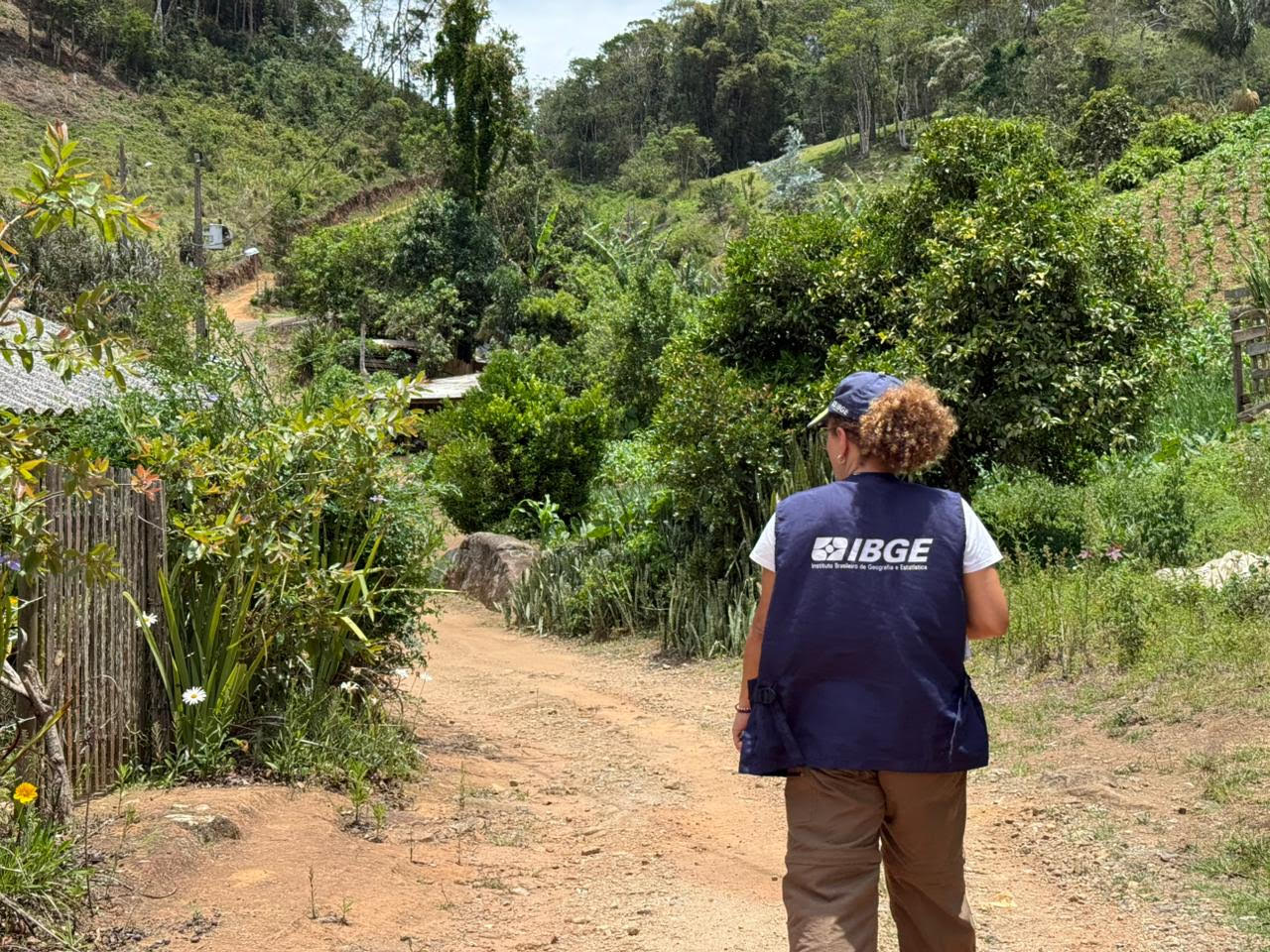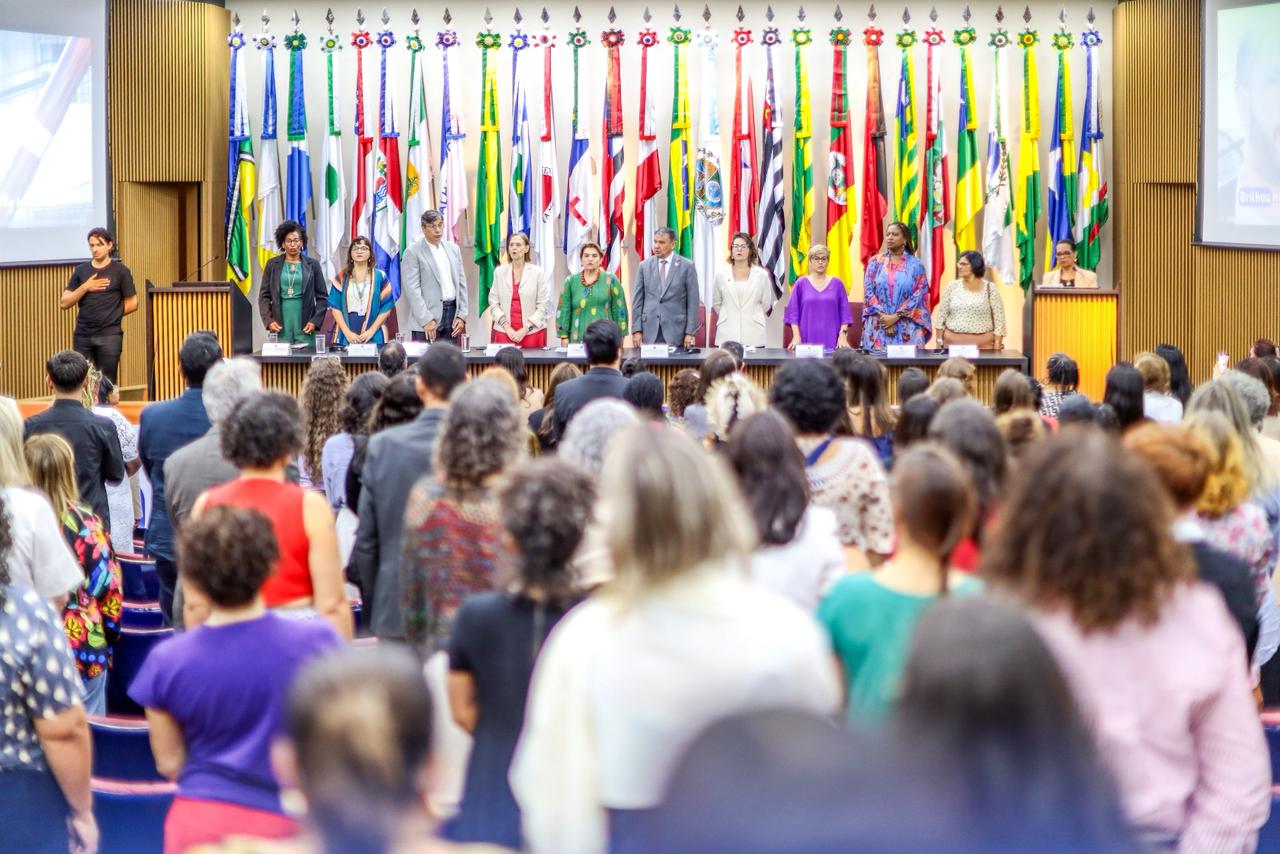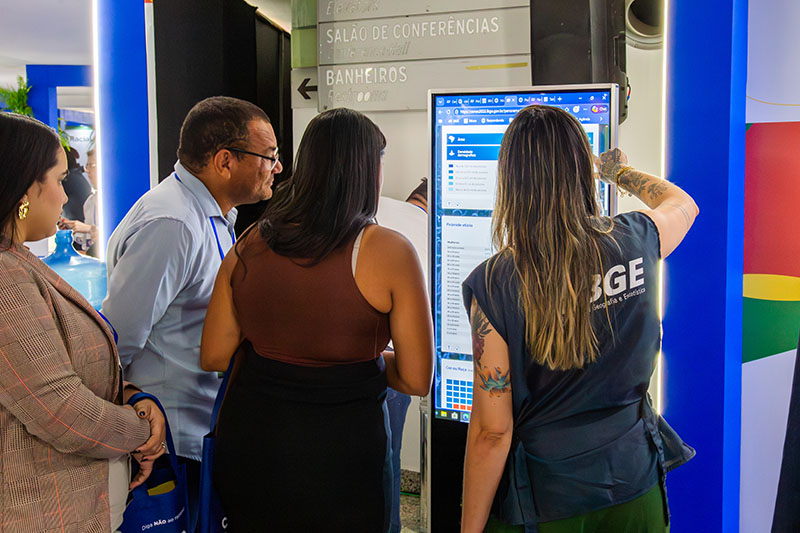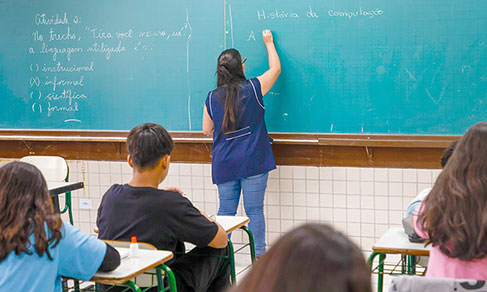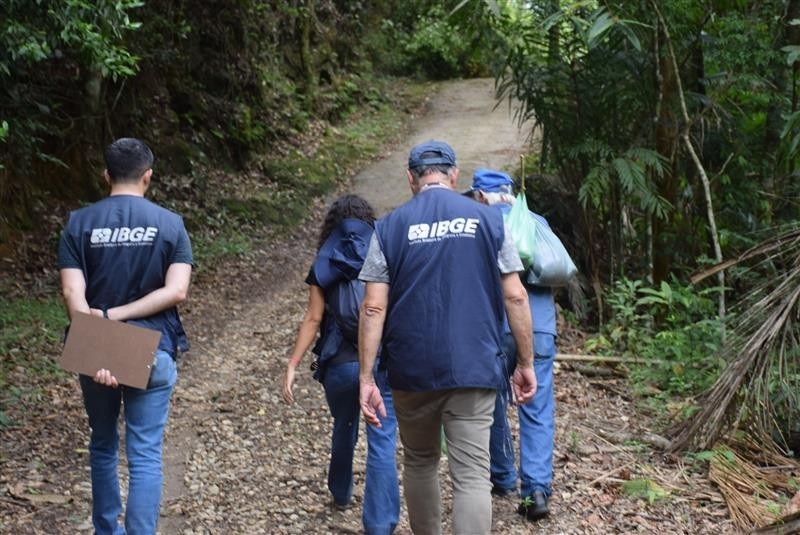2022 Census
2022 Census: Illiteracy rate falls from 9.6% to 7.0% in 12 years, though inequalities persist
May 17, 2024 10h00 AM | Last Updated: May 21, 2024 04h48 PM
Highlights
- In 2022, 163 million persons aged 15 years and over lived in Brazil, of which 151.5 knew how to write a simple note and 11.4 million did not know. In other words, the literacy rate was 93.0% in 2022 and the illiteracy rate, 7.0% of the this population.
- In the 2010 Census, the literacy and illiteracy rates were 90.4% and 9.6%. In 1940, less than half of the population aged 15 years and over (44.0%) was literate.
- The age groups between 15 and 19 years and between 20 and 24 years registered the lowest illiteracy rate (1.5%) and that aged 65 years and over remained with the highest rate (20.3%). Nevertheless, the elderly group recorded the biggest drop in two decades, changing from 38.0% in 2000 to 29.4% in 2010 to 20.3% in 2022, a reduction of 17.7 pp (drop of 46.7%).
- The illiteracy rates of black (10.1%) and brown (8.8%) persons are more than twice that of white persons (4.3%). It is nearly four times higher for the indigenous color or race (16.1%).
- The distance between the white population and the black, brown and indigenous populations was higher in 2010 (8.5; 7; and 17.4 pp), dropping to 5.8; 4.5; and 11.7 pp in 2022. The advantage of the white population occurs in every age group.
- The 1,366 municipalities between 10,001 and 20,000 inhabitants showed the highest average illiteracy rate (13.6%), more than four times the rate of the 41 municipalities above 500,000 inhabitants (3.2%).
- Despite the increase from 80.9% in 2010 to 85.8% in 2022, the literacy rate in the Northeast Region remained the lowest one. The South and Southeast have literacy rates above 96%.
- The illiteracy rate in the Northeast (14.2%) remains twice the national average (7.0%).
- In terms of Federation Units, the highest literacy rates were registered in Santa Catarina (97.3%) and Federal District (97.2%), and the lowest ones, in Alagoas (82.3%) and Piauí (82.8%).
- The literacy rate of the indigenous persons, including those who consider themselves indigenous according to the belonging criteria, was 85.0% in 2022, rising in every region and age group.
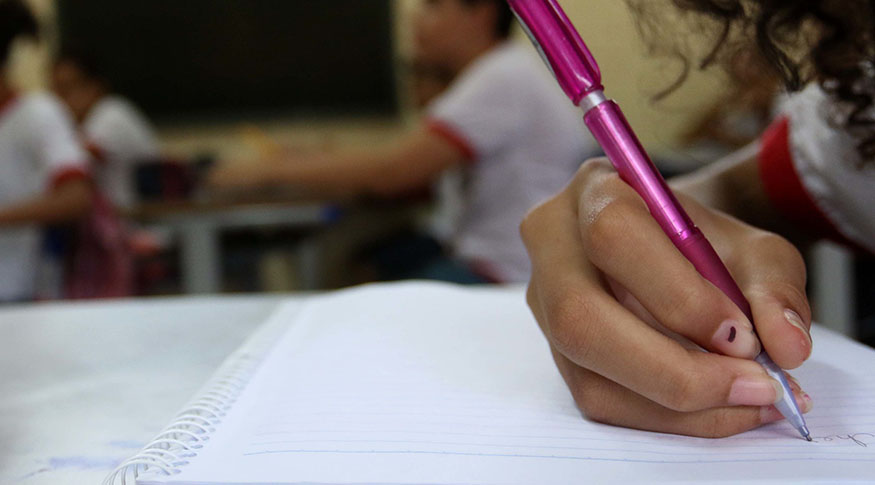
Data from the 2022 Population Census show that, of the 163 million persons aged 15 years and over, 151.5 knew how to write a simple note and 11.4 million did not know. Therefore, the literacy rate for this group was 93.0% in 2022 and the illiteracy rate, 7.0%. In the 2010 Census, the literacy and illiteracy rates were 90.4% and 9.6%.
This information is part of the release 2022 Population Census Literacy - Population Results. The data will be presented today (17), at 10 AM, in an event at the Unidos de Vila Maria Samba School, in the neighborhood of Jardim Japão, São Paulo. The event will be broadcast by Digital IBGE and through the IBGE´s social media: YouTube, Instagram and Facebook. The data can also be accessed on SIDRA, in the Census Overview and in the Interactive Geographic Platform (PGI), in which they can be viewed by means of interactive maps.
This theme has been investigated since the first Brazilian Census in 1872. In 1940, less than half of the population (44.0%) was literate.
White and yellow persons aged 15 years and over registered the lowest illiteracy rates, 4.3% and 2.5%, respectively. On the other hand, black, brown and indigenous persons in the same age group recorded rates of 10.1%, 8.8% and 16.1%, respectively.
In other words, the illiteracy rates of black and brown persons are more than twice that of the white persons, and nearly four times in the case of indigenous persons. Between 2010 and 2022, the difference between white and black persons fell from 8.5 to 5.8 pp and the advantage also became smaller in relation to brown (from 7.1 pp to 4.3 pp) and indigenous persons (from 17.4 pp to 11.7 pp).

All age groups dropped their illiteracy rates
The drop in the illiteracy rate occurred in all the age groups. In 2022, the youngest group aged between 15 and 19 years hit the lowest illiteracy rate (1.5%) and the group aged 65 years and over remained with the highest illiteracy rate (20.3%), though it registered the biggest drop in three decades, changing from 38.0% in 2022 to 29.4% in 2010 to 20.3% in 2022, a reduction of 17.7 pp since 2000 (drop of 46.7%).
“This behavior mainly reflects the educational expansion, which universalized the access to primary education in the beginning of the 1990s, as well as the demographic transition, which replaced older and less educated generations with newer and more educated generations,” explains Betina Fresneda, an analyst of the survey.
The analysis of the rates by age and color or race shows that illiteracy for black and brown persons hit values above 2% from the age group between 25 and 34 years onwards, whereas illiteracy for white persons occurred from the age group between 35 and 44 years onwards. The difference between white and black persons hit its peak for the group aged 65 years and over (20.9 pp).
“The high illiteracy rate among older persons is reflection of the Brazilian educational debt, characterized by a late investment in education, both in the schooling of children and in the access to literacy programs of youngsters and adults by a parcel of persons who were not taught in the proper ages,” says the analyst of the survey.

Only in the range aged 65 and over, men´s literacy is bigger than women´s
In 2022, the percentage of women who knew reading and writing was 93.5% against 92.5% for men. This advantage is found in all the age groups, except for that aged 65 years and over, with 79.9% for men and 79.6% for women. The biggest difference was in the group aged between 45 and 54 years, more 2.7 pp for women.
Illiteracy rate in small municipalities is four times higher than that of cities over 500 thousand inhabitants
The illiteracy rate was lower than the national average only in the municipalities over 100,000 inhabitants. The 1,366 municipalities with a population between 10,001 and 20,000 inhabitants showed the highest average illiteracy rate of persons aged 15 years and over (13.6%). This rate is more than four times that calculated for the 41 municipalities whose population was over 500,000 inhabitants (3.2%).
“Literacy is a responsibility of municipalities and it is directly related to the resources the municipalities have to invest in education. The illiteracy rate is lower in municipalities over 100 thousand inhabitants because they have more resources and infrastructure for education, as well as other factors like location, average age and urban or rural areas,” highlights Betina Fresneda.
In all the size classes, the five municipalities with the lowest illiteracy rate are from either the South Region or São Paulo. In the range up to 10 thousand inhabitants, the highlights are: São Joao do Oeste/SC (0.9%), Westfália/RS (1.1%), Rio Fortuna/SC (1.2%), Águas de São Pedro/SP (1.2%) and São Vendelino/RS (1.3%). Among the municipalities above 500 thousand inhabitants, the highlights are Florianópolis/SC (1.4%), Curitiba/PR (1.5%), Joinville/SC (1.6%), Porto Alegre/RS (1.7%) and Santo André/SP (2.0%).
The highest illiteracy rates were found in the Northeast Region, which comprised 22 out of 25 municipalities selected. The highest rates are in the classes up to 10 thousand inhabitants, all of them in Piauí - Floresta do Piauí (34.7%), Aroeiras do Itaim (34.6%), Massape do Piauí (34.3%), Paquetá do Piauí (34.3%) and Padre Marcos (34.0%); and, in the range between 10 thousand and 50 thousand inhabitants – Alto Alegre/RR (36.8%), Estrela de Alagoas/Al (34.2%), Traipu/AL (32.7%), Pedro Alexandre/BA (31.9%) and Amajari/RR (31.8%).
| Resident persons and illiteracy rate of persons aged 15 years and over by size class of the population of municipalities, according to selected municipalities - Brazil – 2022 | ||||
|---|---|---|---|---|
| Municipalities with the 5 lowest illiteracy rates | Municipalities with the 5 highest illiteracy rates | |||
| Municipality | Rate | Municipality | Rate | |
| Up to 10 thousand | São João do Oeste (SC) | 0.9 | Padre Marcos (PI) | 34.0 |
| Westfália (RS) | 1.1 | Paquetá (PI) | 34.3 | |
| Rio Fortuna (SC) | 1.2 | Massapê do Piauí (PI) | 34.3 | |
| Águas de São Pedro (SP) | 1.2 | Aroeiras do Itaim (PI) | 34.6 | |
| São Vendelino (RS) | 1.3 | Floresta do Piauí (PI) | 34.7 | |
| Municipality | Rate | Municipality | Rate | |
| Between 10 thousand and 50 thousand | Bom Princípio (RS) | 1.3 | Amajari (RR) | 31.8 |
| Feliz (RS) | 1.4 | Pedro Alexandre (BA) | 31.9 | |
| Pomerode (SC) | 1.4 | Traipu (AL) | 32.7 | |
| Dois Irmãos (RS) | 1.4 | Estrela de Alagoas (AL) | 34.2 | |
| Teutônia (RS) | 1.4 | Alto Alegre (RR) | 36.8 | |
| Municipality | Rate | Municipality | Rate | |
| More than 50 thousand up to 100 thousand | São Bento do Sul (SC) | 1.7 | Coroatá (MA) | 23.8 |
| Campo Bom (RS) | 1.8 | Boa Viagem (CE) | 24.3 | |
| Itapema (SC) | 1.9 | Icó (CE) | 25.9 | |
| Farroupilha (RS) | 1.9 | Buíque (PE) | 28.8 | |
| Indaial (SC) | 2.0 | Granja (CE) | 29.0 | |
| Municipality | Rate | Municipality | Rate | |
| More than 100 thousand up to 500 thousand | São Caetano do Sul (SP) | 1.2 | Itabaiana (SE) | 16.0 |
| Balneário Camboriú (SC) | 1.2 | Caxias (MA) | 17.5 | |
| Blumenau (SC) | 1.4 | Lagarto (SE) | 18.4 | |
| Jaraguá do Sul (SC) | 1.4 | Breves (PA) | 18.9 | |
| Santos (SP) | 1.6 | Codó (MA) | 22.3 | |
| Municipality | Rate | Municipality | Rate | |
| More than 500 thousand | Florianópolis (SC) | 1.4 | Feira de Santana (BA) | 6.6 |
| Curitiba (PR) | 1.5 | Natal (RN) | 6.6 | |
| Joinville (SC) | 1.6 | Teresina (PI) | 7.1 | |
| Porto Alegre (RS) | 1.7 | Jaboatão dos Guararapes (PE) | 7.2 | |
| Santo André (SP) | 2.0 | Maceió (AL) | 8.4 | |
South and Southeast have literacy rates above 96%
The South Region remained with the highest literacy rate, which increased from 94.9% in 2010 to 96.6% in 2022. It is followed by the Southeast Region, which changed from 94.6% in 2010 to 96.1% in 2022. Despite the increase from 80.9% in 2010 to 85.8% in 2022, the literacy rate in the Northeast Region remained the lowest one. The second lowest literacy rate is in the North Region, whose indicator followed the national trend, increasing from 88.8% in 2010 to 91.8% in 2022, standing closer to the that of the Central-West Region, which changed from 92.8% in 2010 to 94.9% in 2022.
Illiteracy rate in the Northeast remains twice the national average
Illiteracy in the Northeast Region (14.2%) remained twice the national average (7.0%); in 2010, the rates were 19.1% and 9.6%, respectively. The illiteracy rates in the North and Northeast were above 2% since the first age group in 2022. In the Central-West, it occurred between 35 and 44 years onwards and only between 45 and 54 years onwards in the South and Southeast.
While the illiteracy rate was lower than 2% among persons up to 44 years in the Southeast and South, the youngest group, between 15 and 19 years, did not even reach illiteracy percentages below 2% in the North (2.2% of illiterate persons) and Northeast (2.4% of illiterate persons). Persons aged 65 years and over in the Northeast have a illiteracy rate (39.4%) 3.5 times higher than that registered in the South Region (11.3%) for the same age group.
Santa Catarina has the highest literacy rate, Alagoas, the lowest one
Among the Federation Units, the highest literacy rates were recorded in Santa Catarina (97.3%) and in the Federal District (97.2%), and the lowest ones, in Alagoas (82,3%) and Piauí (82,8%). In 2010, the difference between the highest and the lowest literacy rates, i.e., between the Federal District and Alagoas was 20.9 pp, whereas this percentage dropped to 15.0 pp between Santa Catarina and Alagoas in 2022. Between the 2010 and 2022 censuses, Alagoas was the Federation Unit that mostly increased the percentage of literate persons aged 15 years and over, an expansion of 6.7 pp, a result that was not sufficient to remove it from the last position.

Literacy rate of indigenous persons was 85.0% in 2022
In the 2022 Census, an indigenous person was defined as the one who lives in indigenous localities and self declared as either an indigenous person in the “color or race” question or in the “consider as an indigenous person” question, as well as a person who lives outside indigenous localities and self declared as an indigenous person in the “color or race” question. Therefore, the total number of indigenous persons might be higher than the total number of persons with an indigenous color or race.
The results of the 2022 Population Census show 1,187,246 indigenous persons aged 15 years and over in Brazil, of which 1,008,539 knew reading and writing a simple note and 178,707 did not know it. In other words, the literacy rate of the indigenous persons was 85.0% in 2022, below the national rate (93.0%). The illiteracy rate of this population was 15.1%, above the national rate (7.0%).
The highest literacy rates of indigenous persons are found in the Southeast (91.7%), South (89.4%) and Central-West (87.3%). The lowest ones were in the Northeast (82.0%) and North (84.7%).
Illiteracy rate of indigenous persons dropped in all the regions and age ranges
Between 2010 and 2022, the illiteracy rate of the indigenous persons fell from 23.4% to 15.1%. Reductions were registered in all the regions, the sharpest one being in the North Region (from 31.3% to 15.3%), followed by the Central-West (from 20.8% to 12.7%) and Northeast (from 24.4% to 18.0%). The Southeast Region recorded the smallest drop in the illiteracy rate of indigenous persons, which changed from 10.5% to 8.3% and the South, the second smallest, changing from 15.7% to 10.6%.
The drop in the illiteracy rate of indigenous persons occurred in all the age ranges, with the biggest reductions in the ranges between 35 and 44 (from 22.9% to 12.0%), between 55 and 64 (from 38.3% to 27.4%) and between 25 and 34 years of age (from 17.4% to 6.7%). “It reflected the investment in a distinctive education of children, youngsters and indigenous adults in the inter-census period, as well as the improvement of the ethnic-indigenous belonging outside indigenous lands, when compared with 2010,” says Marta Antunes, IBGE´s Coordinator of the Census of Traditional Communities and Peoples.
Indigenous men aged 15 years and over have a literacy rate of 85.7%, 1.4 pp above the literacy rate of the indigenous women (84.3%). The disaggregation of the literacy rate of indigenous persons by sex and age group shows that indigenous women have a slightly higher literacy rate between 15 and 34 years of age. From 35 years onwards, the literacy rate of indigenous men becomes higher, with the biggest differences (4.7 pp) for the group aged 65 years and over, which points out for a likely higher access of indigenous women to education in the younger age ranges.
More about the survey
The survey “2022 Census Literacy: Population Results” brings another thematic release of the result of the 2022 Population Census, approaching the information relative to the literacy of the Brazilian population. In this release, the data include the geographies Brazil, Major Regions, Federation Units and Municipalities. They are also disaggregated according to color or race,indigenous persons, sex and age groups of residents.



